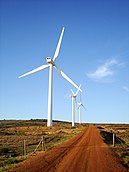 Global Information
Global InformationRenewable energy information
| Part of a series on |
| Sustainable energy |
|---|
 |
|
Renewable energy (or green energy, low-carbon energy) is energy from renewable natural resources that are replenished on a human timescale. Mainstream renewable energy options include solar energy, wind power, hydropower, bioenergy and geothermal power. Renewable energy installations can be large or small. They are suited for urban as well as rural areas. Renewable energy is often deployed together with further electrification. This has several benefits: electricity can move heat or objects efficiently, and is clean at the point of consumption.[1][2] Variable renewable energy sources are those that are not dispatchable due to their fluctuating nature, such as wind power and solar power. In contrast, controllable renewable energy sources include dammed hydroelectricity, bioenergy, or geothermal power. Using renewable energy and energy efficiency technologies is resulting in more energy security, climate change mitigation, and economic benefits.[3]
From 2011 to 2021, renewable energy grew from 20% to 28% of global electricity supply. Use of fossil energy shrank from 68% to 62%, and nuclear from 12% to 10%. The share of hydropower decreased from 16% to 15% while power from sun and wind increased from 2% to 10%. Biomass and geothermal energy grew from 2% to 3%.[4][5]
Renewable energy systems are rapidly becoming more efficient and cheaper. As a result, their share of the global energy consumption is increasing.[6] A large majority of worldwide newly installed electricity capacity is now renewable.[7] In most countries, photovoltaic solar or onshore wind are the cheapest new-build electricity.[8] Renewable energy can help reduce energy poverty in rural and remote areas of developing countries, where lack of energy access is often hindering economic development.
Many countries around the world already have renewable energy contributing more than 20% of their total energy supply. Some countries generate over half their electricity from renewables.[9] A few countries generate all their electricity from renewable energy.[10] National renewable energy markets are projected to continue to grow strongly in the 2020s and beyond.[11] According to the IEA, to achieve net zero emissions by 2050, 90% of global electricity generation will need to be produced from renewable sources.[12]
Renewable energy resources exist all over the world. This is in contrast to fossil fuels resources which are concentrated in a limited number of countries. However, the deployment of renewable energy is being hindered by massive fossil fuel subsidies.[13] In 2022 the International Energy Agency requested all countries to reduce their policy, regulatory, permitting and financing obstacles for renewables.[14] This would increase the chances of the world reaching net zero carbon emissions by 2050.[14]
There are ongoing debates around the renewable energy topic. For example, whether nuclear power should be grouped under the renewable energy category or not. There are also debates around geopolitics, the metal and mineral extraction needed for solar panels and batteries, possible installations in conservation areas and the need to recycle solar panels. Although most renewable energy sources are sustainable, some are not. For example, some biomass sources are unsustainable at current rates of exploitation.[15]
There are also other renewable energy technologies that are still under development, for example enhanced geothermal systems, concentrated solar power, cellulosic ethanol, and marine energy.[16][17]
- ^ Armaroli, Nicola; Balzani, Vincenzo (2011). "Towards an electricity-powered world". Energy and Environmental Science. 4 (9): 3193–3222. doi:10.1039/c1ee01249e.
- ^ Armaroli, Nicola; Balzani, Vincenzo (2016). "Solar Electricity and Solar Fuels: Status and Perspectives in the Context of the Energy Transition". Chemistry – A European Journal. 22 (1): 32–57. doi:10.1002/chem.201503580. PMID 26584653.
- ^ International Energy Agency (2012). "Energy Technology Perspectives 2012". Archived from the original on 28 May 2020. Retrieved 2 December 2020.
- ^ "Renewables 2022". Global Status Report (renewable energies): 44. 14 June 2019. Retrieved 5 September 2022.
- ^ REN21 Renewables Global Status Report 2021.
- ^ "Global renewable energy trends". Deloitte Insights. Archived from the original on 29 January 2019. Retrieved 28 January 2019.
- ^ "Renewable Energy Now Accounts for a Third of Global Power Capacity". irena.org. 2 April 2019. Archived from the original on 2 April 2019. Retrieved 2 December 2020.
- ^ IEA (2020). Renewables 2020 Analysis and forecast to 2025 (Report). p. 12. Archived from the original on 26 April 2021. Retrieved 27 April 2021.
- ^ Ritchie, Hannah; Roser, Max; Rosado, Pablo (January 2024). "Renewable Energy". Our World in Data.
- ^ Sensiba, Jennifer (28 October 2021). "Some Good News: 10 Countries Generate Almost 100% Renewable Electricity". CleanTechnica. Archived from the original on 17 November 2021. Retrieved 22 November 2021.
- ^ REN21 Renewables Global Futures Report 2017.
- ^ "Net Zero by 2050 – Analysis". IEA. 18 May 2021. Retrieved 19 March 2023.
- ^ Timperley, Jocelyn (20 October 2021). "Why fossil fuel subsidies are so hard to kill". Nature. 598 (7881): 403–405. Bibcode:2021Natur.598..403T. doi:10.1038/d41586-021-02847-2. PMID 34671143. S2CID 239052649.
- ^ a b "Executive summary – Renewables 2022 – Analysis". IEA. Retrieved 13 March 2023.
Our accelerated case shows global renewable capacity can expand by an additional 25% compared with the main forecast if countries address policy, regulatory, permitting and financing challenges. …… This faster increase would significantly narrow the gap on the amount of renewable electricity growth that is needed in a pathway to net zero emissions by 2050.
- ^ Timperly, Jocelyn (23 February 2017). "Biomass subsidies 'not fit for purpose', says Chatham House". Carbon Brief Ltd © 2020 - Company No. 07222041. Archived from the original on 6 November 2020. Retrieved 31 October 2020.
- ^ Cite error: The named reference
:7was invoked but never defined (see the help page). - ^ Cite error: The named reference
IEAwas invoked but never defined (see the help page).



